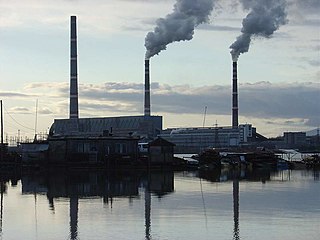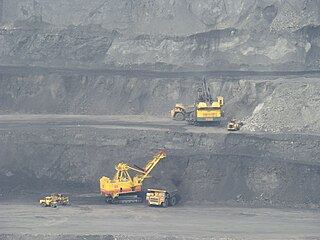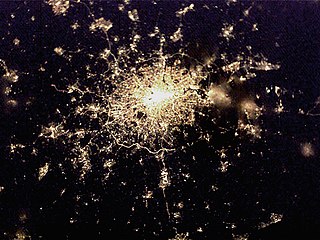
A carbon tax is a tax levied on the carbon content of fuels and, like carbon emissions trading, is a form of carbon pricing. The term carbon tax is also used to refer to a carbon dioxide equivalent tax, the latter of which is quite similar but can be placed on any type of greenhouse gas or combination of greenhouse gases, emitted by any economic sector.

A carbon footprint is historically defined as the total emissions caused by an individual, event, organization, or product, expressed as carbon dioxide equivalent. Greenhouse gases (GHGs), including carbon dioxide, can be emitted through land clearance and the production and consumption of food, fuels, manufactured goods, materials, wood, roads, buildings, transportation and other services.

Ensuring adequate energy supply to sustain economic growth has been a core concern of the Chinese government since 1949. Primary energy use in China was 26,250 TWh and 20 TWh per million persons in 2009. According to the International Energy Agency, the primary energy use grew 40% and electricity use 70% from 2004 to 2009.

A greenhouse gas is a gas that absorbs and emits radiant energy within the thermal infrared range. Greenhouse gases cause the greenhouse effect. The primary greenhouse gases in Earth's atmosphere are water vapor, carbon dioxide, methane, nitrous oxide and ozone. Without greenhouse gases, the average temperature of Earth's surface would be about −18 °C (0 °F), rather than the present average of 15 °C (59 °F). The atmospheres of Venus, Mars and Titan also contain greenhouse gases.

Energy in Australia is the production in Australia of energy and electricity, for consumption or export. Energy policy of Australia describes the politics of Australia as it relates to energy.

According to official statistics, there has been a reduction in domestic greenhouse gas emissions in the United Kingdom. These emissions are caused primarily by primary energy consumption. If indirect emissions are accounted for, however, research suggests that UK emissions may have increased since 1990, due largely to manufacture of short-term consumer items overseas.
The environment of Luxembourg has been affected by the country' rapid population growth, its heavy road traffic and its lack of renewable energy resources.

The total electricity consumption of the Netherlands in 2013 was 119 terawatt-hour (TWh). The consumption grew from 7 TWh in 1950, with an average of 4.5% per year. As of 2012, the main resources for electricity in the Netherlands are fossil fuels, such as natural gas and coal. In 2012, fossil fuels accounted for 81% of the produced electricity. Renewable energy sources, such as biomass, wind power and solar power, produce 12% of the total electricity. There is one nuclear plant in the Netherlands, in Borssele, which is responsible for about 3.5% of total generation. The majority of the electricity, more than 60%, is produced centrally by thermal and nuclear units.

The electricity sector in Belgium describes electricity in Belgium. Production by power source in 2009 was 53% nuclear, 40% fossil electricity and 7% renewable electricity. 2% of production was exported in 2009. In 2008 import was 11%. Belgium is highly nuclear dependent country where the share of renewable electricity has been low. The share of renewable electricity was about 2% in 2005. Plan for 2020 is wind 10.5 TWh (9.5%), biomass 11 TWh and PV 1 TWh.

Electricity sector in Luxembourg describes electricity issues in Luxembourg. Luxembourg is a member of OECD and European Union. Luxembourg imports most of its energy. Luxembourg is the EU country with the second smallest forecast of renewables in 2020. Luxembourg has one of the highest emissions of carbon dioxide per person in Europe.

Energy policy of Belgium describes the politics of Belgium related to energy. Energy in Belgium describes energy and electricity production. consumption and import in Belgium. Electricity sector in Belgium is the main article of electricity in Belgium.

Energy in Sweden describes energy and electricity production, consumption and import in Sweden. Electricity sector in Sweden is the main article of electricity in Sweden. The Swedish climate bill of February 2017 aims to make Sweden carbon neutral by 2045. The Swedish target is to decline emission of climate gases 63% from 1990 to 2030 and international transportation excluding foreign flights 70%. By 2014 just over half of the country's total final energy consumption in electricity, heating and cooling and transport combined was provided by renewables, the highest share amongst the 28 EU member countries.
Energy in the Czech Republic describes energy and electricity production, consumption and import in the Czech Republic.

Primary energy use in Slovakia was 194 TWh and 36 TWh per million inhabitants in 2009.

Coal in Europe describes coal as energy fuel in Europe today. Coal includes hard coal, brown coal, and lignite.

An emissions budget, carbon budget, emissions quota, or allowable emissions, is an upper limit of total carbon dioxide emissions associated with remaining below a specific global average temperature. An emissions budget may also be associated with objectives for other related climate variables, such as radiative forcing.





















